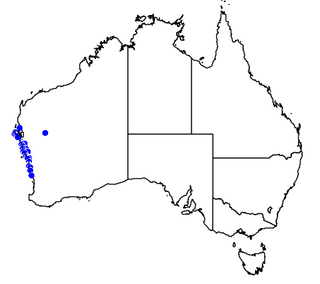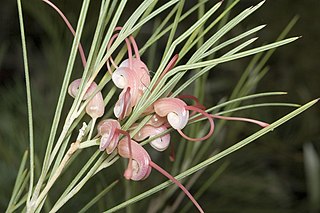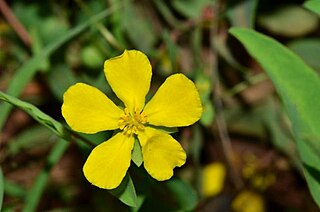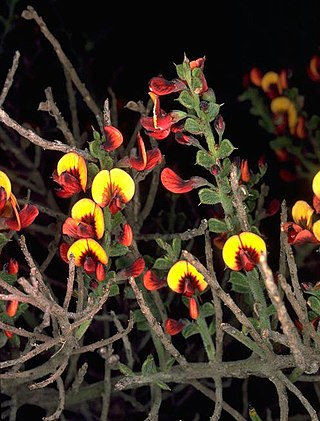
Commersonia borealis is a species of flowering plant in the family Malvaceae and is endemic to the southwest of Western Australia. It is a low growing, spreading shrub with egg-shaped to oblong leaves, and white, yellow and cream-coloured flowers.
Grevillea eremophila is a species of flowering plant in the family Proteaceae and is endemic to the south-west of Western Australia. It is an erect shrub with leathery, linear to narrowly egg-shaped leaves with the narrower end towards the base, and creamy-white flowers.

Grevillea incrassata is a species of flowering plant in the family Proteaceae and is endemic to inland south-western Western Australia. It is an erect shrub with crowded cylindrical or narrowly linear leaves and clusters of bright yellow flowers.
Grevillea incurva is a species of flowering plant in the family Proteaceae and is endemic to inland south-western Western Australia. It is an erect shrub with linear adult leaves and clusters of creamy-yellow flowers.

Grevillea oncogyne is a species of flowering plant in the family Proteaceae and is endemic to inland areas of Western Australia. It is an erect to spreading shrub with linear, sometimes lobed leaves, and clusters of red or pinkish red flowers.

Leucopogon tamminensis is a species of flowering plant in the heath family Ericaceae and is endemic to the southwest of Western Australia. It is a slender shrub with many branches, overlapping triangular to egg-shaped leaves and white, tube-shaped flower arranged singly in upper leaf axils.

Philotheca tomentella is a species of flowering plant in the family Rutaceae and is endemic to the south-west of Western Australia. It is an undershrub with small club-shaped to cylindrical leaves and white flowers with a pale red central stripe, arranged singly or in groups of up to four on the ends of branchlets.

Androcalva luteiflora is a species of flowering plant in the family Malvaceae and is endemic to western Australia. It is an erect, sucker-forming shrub with egg-shaped leaves, the edges irregularly toothed, and clusters of 3 to 18 or more yellow flowers.
Goodenia eremophila is a species of flowering plant in the family Goodeniaceae and is endemic to inland areas of Western Australia. It is an ascending herb with linear to elliptic leaves and thyrses of blue flowers.
Teucrium myriocladum is a species of flowering plant in the family Lamiaceae and is endemic to the south-west of Western Australia. It is a shrub with small, hairy leaves and creamy-green flowers.
Goodenia nuda is a species of flowering plant in the family Goodeniaceae and is endemic to the Pilbara region of Western Australia. It is an erect to ascending herb with elliptic to lance-shaped leaves at the base of the plant, and racemes of yellow flowers.
Pultenaea arida is a species of flowering plant in the family Fabaceae and is endemic to the south of Western Australia. It is a low, spindly, spreading shrub with small, flat, hairy leaves and yellow, red or orange flowers.

Hibbertia silvestris is a species of flowering plant in the family Dilleniaceae and is endemic to the south-west of Western Australia. It is a prostrate to more or less erect or spreading shrub with hairy young branchlets, elliptic to egg-shaped leaves with the narrower end towards the base and yellow flowers with seven to ten stamens on one side of two softly-hairy carpels.

Daviesia decipiens is a species of flowering plant in the family Fabaceae and is endemic to the south-west of Western Australia. It is an intricately-branched shrub with scattered, sharply-pointed oblong or tapering phyllodes, and orange, maroon and crimson flowers.

Daviesia dielsii, commonly known as Diels' daviesia, is a species of flowering plant in the family Fabaceae and is endemic to the south-west of Western Australia. It is on intricately-branched shrub with sharply-pointed, egg-shaped, vertically compressed phyllodes, and yellow and red flowers.
Lasiopetalum microcardium is a species of flowering plant in the family Malvaceae and is endemic to the south-west of Western Australia. It is a low, spreading or straggling shrub with hairy stems, heart-shaped leaves and blue, purple or white flowers.

Mirbelia depressa is a species of flowering plant in the family Fabaceae and is endemic to Western Australia. It is an erect or spreading, prickly shrub that typically grows to a height of 0.15–1 m high and has yellow or orange and reddish-brown flowers from August to October. It was first formally described in 1904 by Ernst Georg Pritzel in the Botanische Jahrbücher für Systematik, Pflanzengeschichte und Pflanzengeographie. The specific epithet (depressa) means "pressed down", referring to the low habit of this species. This mirbelia grows on sandplains and is widespread in the Avon Wheatbelt, Coolgardie, Esperance Plains, Geraldton Sandplains, Gibson Desert, Great Victoria Desert, Mallee, Murchison and Yalgoo and bioregions of Western Australia, and is listed as "not threatened" by the Government of Western Australia Department of Biodiversity, Conservation and Attractions.
Pimelea gilgiana is a species of flowering plant in the family Thymelaeaceae and is endemic to near-coastal areas of north-western Western Australia. It is a shrub with narrowly egg-shaped leaves and head-like clusters of white or pinkish, dioecious flowers.
Thomasia multiflora is a species of flowering plant in the family Malvaceae and is endemic to the south-west of Western Australia. It is a low, spreading shrub with broadly egg-shaped leaves and mauve flowers.

Pimelea leucantha is a species of flowering plant in the family Thymelaeaceae and is endemic to near-coastal areas in the west of Western Australia. It is a shrub with linear to narrowly egg-shaped or narrowly elliptic leaves and clusters of white to pale yellow flowers surrounded by 4 or 6 egg-shaped involucral bracts.













